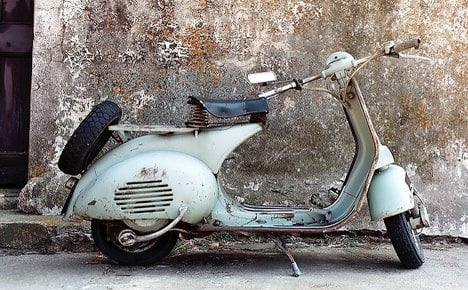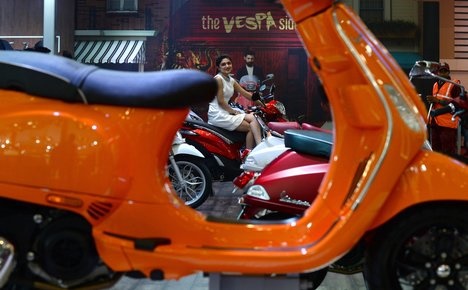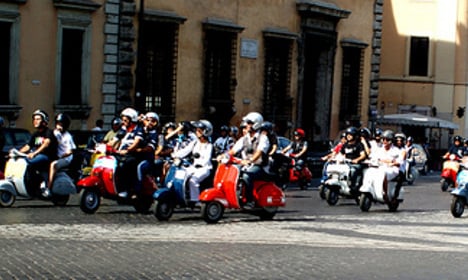It was inspired by war
The Vespa conjures up images of romance and idyllic trips around scenic Italian cities – but it would never have come into being without the Second World War. The fighting left Italy's economy and infrastructure in ruins.
Inspiration came from the American-made Cushman Airborne, a small, steel motorcycle which had been used by Italian troops during the war. Allied planes had dropped the robust, but compact, vehicles by parachute into Milan and Turin so that they could be used by resistance fighters.
Piaggio, the company that created Vespa, was initially founded in the late 19th century as a ship-outfitting business and had expanded into railway construction and manufacturing aircraft. Because of its work in building aircraft, it was a target during the war, and its factories were completely destroyed. Even worse, Italy had signed an agreement not to research or produce aircraft for ten years following the war's end.
But with help from the Allies, the factories were rebuilt, and director Enrico Piaggio decided to get into the motorcycle business, to meet the need for reliable but affordable transport within the cities. In fact, the Vespa played a key role in re-booting Italy's economy after the war and helping the country get back on its feet – or wheels.
SEE ALSO: The history of the Vespa in pictures
Its creator hated motorcycles
Piaggio approached Corradino D'Ascanio to design the new bike. He was an accomplished engineer who had built his own glider at the age of fifteen and designed Italy's first helicopter. D'Ascanio loved manual work and could reportedly crochet, embroider and play the violin.
There was just one problem – he hated motorbikes.
D'Ascanio felt that motorcycles were too bulky, dirty and unreliable, so he set about making a two-wheeled vehicle that didn't feel like a motorcycle. He moved the gears to the handlebars for convenience, and put the engine under the seat, to keep the riders and their clothes protected from oil and grease. The Vespa was born. It got its name, which means 'wasp' in Italian, from the fact that early versions sounded like an insect buzzing.
Hollywood made it a star
Audrey in Vespa – https://t.co/cNLLO7ghB7
Anno: 1953
Posizione: P.zza Venezia n.5
Palazzo Bonaparte alle sue spalle. pic.twitter.com/uSFeBZ7IE3— Roma Ieri Oggi (@romaierioggi) November 11, 2015

Photo: Jean-Paul Gaillard
Piaggio itself has now produced over 150 models of the original Vespa, adapting to changing needs and fashions, and 18 million of its scooters have been sold to date. Over 60,000 people are members of Piaggio's Vespa Club, which has chapters in cities all over the world and hosts annual championships. Here are some the most popular:
The 98cc, 1946 – the very first Vespa, which was in production for two years. It could reach up to 60mph.
125U, 1953 – The 'U' stands for 'utilitarian', but this model is the most sought-after by collectors. It was produced to compete with a rival, the Lambetta, with less focus on how it looked and a reduced cost. Only 7,000 models were ever made.
Vespa 150 TAP, 1956 – Made in France, this model included a reinforced frame and a rifle attached to the scooter's body. In this way the Vespa came full circle; like its inspiration, the Cushman Airborne, the scooters were made to be parachuted in to assist troops on the ground.
Vespa 125 Primavera, 1960s – This is the model that Piaggio can thank for Vespa's longevity and global success. Its small, lightweight frame offered convenience, and it was especially popular with British Mods; the UK actually overtook Italy to become Vespa's largest market during this decade. It was so iconic that the company updated it with a Primavera 150.
Vespa 946, 2013 – Retailing at €10,000 in the US, this version with leather seat and brand new air-cooled engine proved that it had morphed from a cheap transport solution to a highly sought-after fashion accessory.
If you want to get your hands on your own piece of Italian history, read eBay's guide to buying a secondhand Vespa.
The slogans
The original advertising campaign asserted that Vespa was “not a motorcycle – rather a small car with two wheels”. In the 1950s, the slogan 'for your work, for your leisure, Vespa yourselves' created a verb – 'vespizzare' meaning 'to Vespa oneself' while others focussed on the freedom offered by the scooter: “Enjoy Vespa!” “He who Vespas, shines”.
A particularly surreal 1969 slogan read: “Those who Vespa eat apples (those who don't Vespa don't)”. The image of the apple was intended to signify freshness and opportunity, to appeal to young students.
A 1970s slogan continued the apple theme with the slogan “mela compro la vespa” – the play on words, as 'mela' (apple) could be read as 'I… it', means that this translates as “I'll buy it, the Vespa”.
When Italy won the World Cup in 1982, Vespa turned the second line of the national anthem, 'L'Italia s'e desta' (Italy has awakened) into 'L'Italia s'e Vespa' for a patrotic touch.
The current slogan is “With Vespa you can”.
How is Vespa celebrating?
A new multicoloured model will be released later in the year, while the Piaggio Museum launched an exhibition 'On the road with Vespa' on Friday.

Photo: Sajjah Hussain/AFP
To see a gallery of the Vespa models and advertising campaigns through history, click here.



 Please whitelist us to continue reading.
Please whitelist us to continue reading.
Member comments